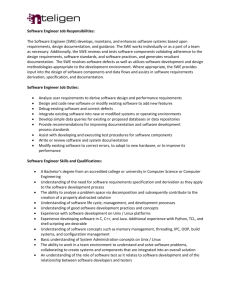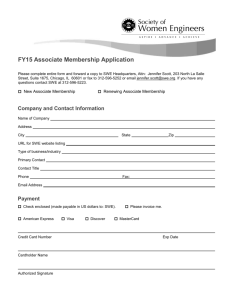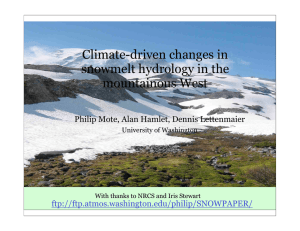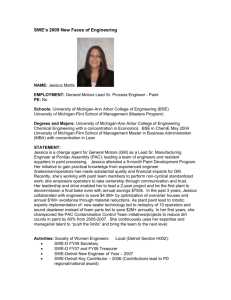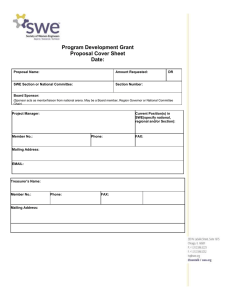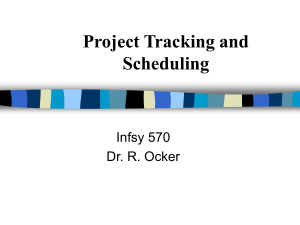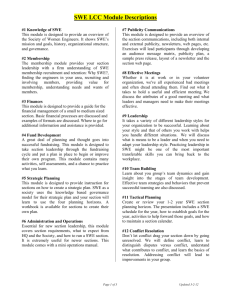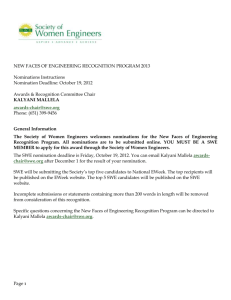gcb12242-sup-0005-supplement
advertisement
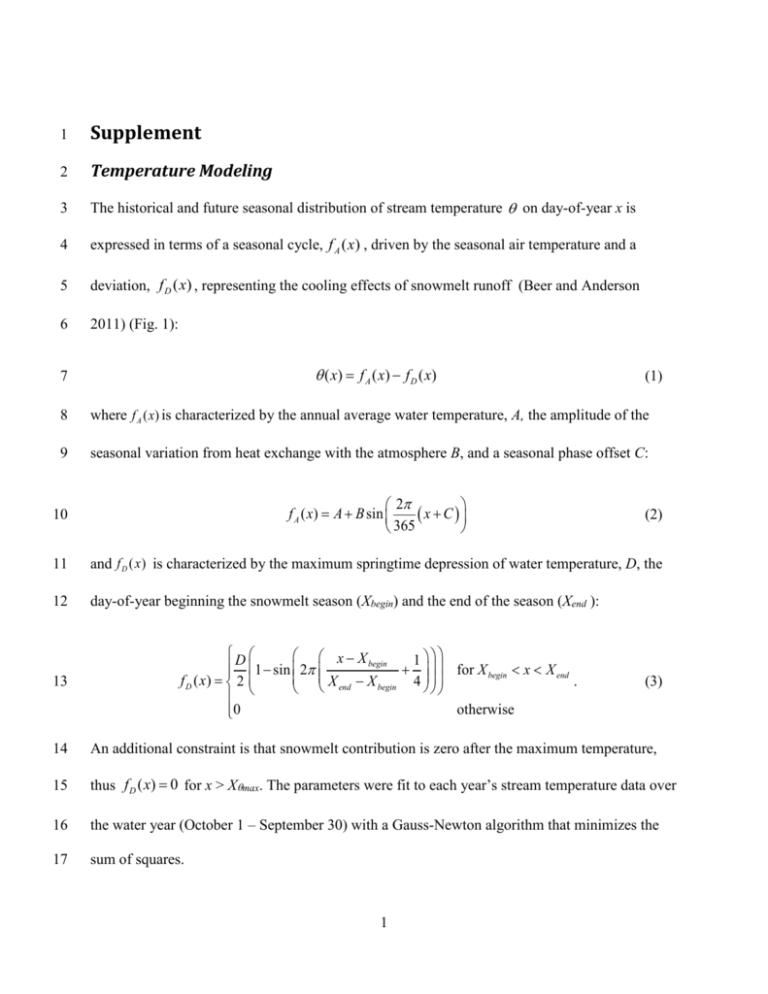
1 Supplement 2 Temperature Modeling 3 The historical and future seasonal distribution of stream temperature on day-of-year x is 4 expressed in terms of a seasonal cycle, f A ( x) , driven by the seasonal air temperature and a 5 deviation, f D ( x) , representing the cooling effects of snowmelt runoff (Beer and Anderson 6 2011) (Fig. 1): ( x) f A ( x) f D ( x) 7 (1) 8 where f A ( x) is characterized by the annual average water temperature, A, the amplitude of the 9 seasonal variation from heat exchange with the atmosphere B, and a seasonal phase offset C: 10 2 f A ( x) A B sin x C 365 11 and f D ( x ) is characterized by the maximum springtime depression of water temperature, D, the 12 day-of-year beginning the snowmelt season (Xbegin) and the end of the season (Xend ): 13 D x X begin 1 for X begin x X end 1 sin 2 f D ( x) 2 . X end X begin 4 otherwise 0 (2) (3) 14 An additional constraint is that snowmelt contribution is zero after the maximum temperature, 15 thus f D ( x) 0 for x > Xmax. The parameters were fit to each year’s stream temperature data over 16 the water year (October 1 – September 30) with a Gauss-Newton algorithm that minimizes the 17 sum of squares. 1 18 For each stream i, a baseline set of site-specific parameters, Pi Ai , Bi , Ci , Di , X begin ,i , X end ,i , was 19 estimated by fitting the model to data aggregated across all available years of stream 20 temperatures. Parameters A and D, which exhibit yearly variations, were also needed, so a set of 21 parameters was fit to water-year, y, giving site- and year-specific parameters 22 Pi , y Ai , y , Bi , y , Ci , y , Di , y , X begin ,i , y , X end ,i , y . Parameters A and D were then related to environmental 23 trends, and hence projected forward to mid-21st century. We assumed that the effects of climate 24 change on other parameters were small. 25 Data 26 Stream temperature data for CA, OR, WA, and ID were obtained from the United States 27 Geological Survey (http://waterdata.usgs.gov/nwis/), California Department of Water Resources, 28 Data Exchange Center (http://cdec.water.ca.gov/), and the Washington State Department of 29 Ecology (http://www.ecy.wa.gov/science/data.html). Daily water temperature values were 30 distinguished by water year (October – September) for fitting the temperature model. Several 31 sites in Washington had only monthly averages. 32 Fitting the data was an iterative process. For example, first the temperature model was fit for a 33 water year within a site (henceforth a “fit-year”). It was then inspected visually to insure that the 34 model was fitting as intended. Any conspicuously anomalous input data was excluded and if 35 model parameters were outside of existing constraints then new fitting constraints were adopted 36 and the entire procedure reapplied to all the data. By the end of the fitting process, all parameters 37 met basic constraints (e.g. 0 < < 20, Xbegin before Xmax and both between the coolest and 38 warmest days, Xmax Xbegin at least 50 days, etc.). All fits used here and many others are shown 39 in supplementary material (available 9 January 2013 at 2 40 http://www.cbr.washington.edu/data/Streams/data.html). An individual site had to have ≥10 41 years-worth of annual parameters so that the air and snow trends could be used to generate site- 42 specific baseline conditions to the year 2010. Missing data were tolerated as long as the six 43 parameters could be obtained. 44 Historic annual mean air temperatures (AIR) for the EPA basins were obtained from Westmap 45 (http://www.cefa.dri.edu/Westmap/). Historical SWE measures for each basin in early April were 46 compiled from Natural Resources Conservation Service SNOTEL data 47 (http://www.nrcs.usda.gov/) and California Department of Water Resources Snow Course data 48 (http://cdec.water.ca.gov/ ). 49 For incomplete series, SWE’s measured over the available years were normalized to find the in- 50 year basin anomaly, then re-computed as a basin-wide measure (Clark et al., 2001; Mote et al., 51 2005). Normalized SWE is i , y SWEi , y SWE i SWE ,i . A missing normalized value at site i in 52 year w was defined i , w 53 then SWEi , w i , w i i and a basin-wide average SWE for each year y was: 54 SWE y 55 Trend prediction 56 For historical trend estimates, available Ai , y data was related to the mean annual air temperature 57 AIRj,y across 22 EPA basins j as Ai , y ai bi AIR j , y i , y . Then, air temperature trends were 58 determined as AIR j , y c j d j y , where y is year. The resulting projected parameter for any year 1 j ,w where m is the number of basin sites. The missing value was m j i 1 SWEi , y where m is the number of basin sites i. m i 3 59 is then Aˆi , y ( x ) ai bi ci bi di y and a mid-century estimate was obtained with y = 2050 (Table 60 S1). 61 Variability in Aˆi , y is assumed to remain the same as in the historic record, so up to k future 62 conditions at site i were generated using: Aˆi ,k Aˆi i , yk with a one-to-one mapping of the (y) 63 set of years to the k new values. 64 Di,y was developed in an analogous manner, beginning with basin-wide, annual estimates of the 65 Snow-Water Equivalent (SWE) for April 1 within basin j. To avoid negative values, basin trends 66 were derived from the log-relationship: log( SWE y ) log( ) log( y ) (Table S1) and the across- 67 year trends in Di,y , were defined Dˆ i , y SWE j , y SWE j ,2010 Dˆ i ,2010 . In addition, Dˆ i ,2050 0 for 68 basins with insignificant snow (South Mohave, North Mohave, South Coast, North Lahontan, 69 Central Coast, San Francisco, and Oregon Basins) . 4
